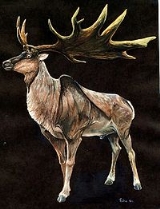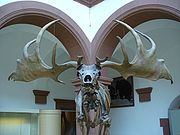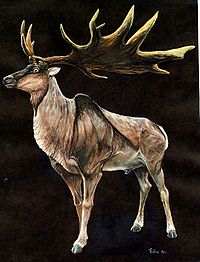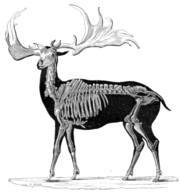
Irish Elk
Encyclopedia
The Irish Elk or Giant Deer (Megaloceros giganteus), was a species of Megaloceros
and one of the largest deer
that ever lived. Its range extended across Eurasia
, from Ireland to east of Lake Baikal
, during the Late Pleistocene
. The latest known remains of the species have been carbon dated to about 7,700 years ago. Although most skeletons have been found in Irish
bog
s, the animal was not exclusively Irish and was not closely related to either of the living species currently called elk - Alces alces (the European elk, known in North America as the moose) or Cervus canadensis (the North American elk or wapiti); for this reason, the name "Giant Deer" is used in some publications.
d from M. antecedens. The earlier taxon
— sometimes considered a paleosubspecies M. giganteus antecedens — is similar but had more complex and compact antlers.
The Irish Elk stood about 2.1 metres (6.9 ft) tall at the shoulders, and it had the largest antlers of any known cervid (a maximum of 3.65 m (12 ft) from tip to tip and weighing up to 40 kilograms (88.2 lb)). In body size, the Irish Elk matched the extant moose
subspecies of Alaska (Alces alces gigas) as the largest known deer. A significant collection of M. giganteus skeletons can be found at the Natural History Museum
in Dublin.
It should be noted that the Irish Elk does not in any way directly correspond to any living species today, including even the Alaskan moose or North American elk. It is taxonomically a giant and completely extinct deer.
 The size of Irish Elk antlers is distinctive, and several theories have arisen as to their evolution
The size of Irish Elk antlers is distinctive, and several theories have arisen as to their evolution
. One theory was that their antlers, under constant and strong sexual selection
, increased in size because males were using them in combat for access to females; it was also suggested that they eventually became so unwieldy that the Irish Elk could not carry on the normal business of life and so became extinct. It was not until Stephen Jay Gould
's important 1974 essay on Megaloceros that this theory was tested rigorously.
Gould demonstrated that for deer in general, species with a larger body size have antlers that are more than proportionately larger, a consequence of allometry, or differential growth rate of body size and antler size during development. Irish Elk had antlers of just the size one would predict from their body size. This does not mean that sexual selection played no part in maintaining large antler size, only that the antlers of the species' ancestors were already large to begin with. Indeed, Gould concluded that the large antler size and their position on the skull was very much maintained by sexual selection: they were morphologically ill-suited for combat between males, but their position was ideal to present them to intimidate rivals or impress females. Unlike other deer, M. giganteus did not even have to turn its head to present the antlers to best effect, but could accomplish this by simply looking straight ahead.
 Discussion of the cause of their extinction has focused on the antler size (rather than on their overall body size), which may be due more to their impact on the observer than any actual property. Some have suggested hunting by man was a contributing factor in the demise of the Irish Elk, as may have been the case with other prehistoric megafauna
Discussion of the cause of their extinction has focused on the antler size (rather than on their overall body size), which may be due more to their impact on the observer than any actual property. Some have suggested hunting by man was a contributing factor in the demise of the Irish Elk, as may have been the case with other prehistoric megafauna
, even assuming that the large antler size restricted the movement of males through forested regions or that it was by some other means a "maladaptation
" (see Gould 1974). But evidence for overhunting is equivocal, and as a continental species, it would have co-evolved with humans throughout its existence and presumably have adapted to their presence.
A folk memory
of the Irish Elk was once thought to be preserved in the Middle High German
word Shelch, a large beast mentioned in the 13th-century Nibelungenlied
along with the then-extant aurochs
(Dar nach schluch er schiere, einen Wisent und einen Elch, Starcher Ure vier, und einen grimmen Schelch / "After this he straightway slew a Bison and an Elk, Of the strong Wild Oxen four, and a single fierce Schelch."). The Middle Irish word segh was also suggested as a reference to the Irish Elk. These interpretations are however, not conclusive.
More recent research pointed out that high amounts of calcium
and phosphate
compounds are required to form antlers, and therefore large quantities of these minerals are required for the massive structures of the Irish Elk. The males (and male deer in general) met this requirement partly from their bones, replenishing them from food plants after the antlers were grown or reclaiming the nutrients from discarded antlers (as has been observed in extant deer). Thus, in the antler growth phase, Giant Deer were suffering from a condition similar to osteoporosis
.
 When the climate changed at the end of the last glacial period, the vegetation in the animal's habitat also changed towards species that presumably could not deliver sufficient amounts of the required minerals, at least in the western part of its range. The most recent specimen of M. giganteus in northern Siberia, dated to approximately 8,000 years ago - well after the end of the last glacial period - shows no sign of nutrient stress. They come from a region with a continental climate
When the climate changed at the end of the last glacial period, the vegetation in the animal's habitat also changed towards species that presumably could not deliver sufficient amounts of the required minerals, at least in the western part of its range. The most recent specimen of M. giganteus in northern Siberia, dated to approximately 8,000 years ago - well after the end of the last glacial period - shows no sign of nutrient stress. They come from a region with a continental climate
where the proposed vegetation changes had not (yet) occurred.
It is easy to advance a number of hypotheses regarding the disappearance of the more localized populations of this species. The situation is less clear regarding the final demise of the Irish Elk in continental Eurasia east of the Urals. Stuart et al. (2004) tentatively suggest that a combination of human presence along rivers and slow decrease in habitat quality in upland areas presented the last Irish Elk with the choice of either good habitat but considerable hunting pressure, or general absence of humans in a suboptimal habitat.
. University of California Press. ISBN 0-520-20277-5.
Megaloceros
The deer of the genus Megaloceros - ; see also Lister - were found throughout Eurasia from the late Pliocene to the Late Pleistocene, and were important herbivores during the Ice Ages. The largest species, M...
and one of the largest deer
Deer
Deer are the ruminant mammals forming the family Cervidae. Species in the Cervidae family include white-tailed deer, elk, moose, red deer, reindeer, fallow deer, roe deer and chital. Male deer of all species and female reindeer grow and shed new antlers each year...
that ever lived. Its range extended across Eurasia
Eurasia
Eurasia is a continent or supercontinent comprising the traditional continents of Europe and Asia ; covering about 52,990,000 km2 or about 10.6% of the Earth's surface located primarily in the eastern and northern hemispheres...
, from Ireland to east of Lake Baikal
Lake Baikal
Lake Baikal is the world's oldest at 30 million years old and deepest lake with an average depth of 744.4 metres.Located in the south of the Russian region of Siberia, between Irkutsk Oblast to the northwest and the Buryat Republic to the southeast, it is the most voluminous freshwater lake in the...
, during the Late Pleistocene
Late Pleistocene
The Late Pleistocene is a stage of the Pleistocene Epoch. The beginning of the stage is defined by the base of the Eemian interglacial phase before the final glacial episode of the Pleistocene 126,000 ± 5,000 years ago. The end of the stage is defined exactly at 10,000 Carbon-14 years BP...
. The latest known remains of the species have been carbon dated to about 7,700 years ago. Although most skeletons have been found in Irish
Ireland
Ireland is an island to the northwest of continental Europe. It is the third-largest island in Europe and the twentieth-largest island on Earth...
bog
Bog
A bog, quagmire or mire is a wetland that accumulates acidic peat, a deposit of dead plant material—often mosses or, in Arctic climates, lichens....
s, the animal was not exclusively Irish and was not closely related to either of the living species currently called elk - Alces alces (the European elk, known in North America as the moose) or Cervus canadensis (the North American elk or wapiti); for this reason, the name "Giant Deer" is used in some publications.
Description
Megaloceros giganteus first appeared about 400,000 years ago. It possibly evolveEvolution
Evolution is any change across successive generations in the heritable characteristics of biological populations. Evolutionary processes give rise to diversity at every level of biological organisation, including species, individual organisms and molecules such as DNA and proteins.Life on Earth...
d from M. antecedens. The earlier taxon
Taxon
|thumb|270px|[[African elephants]] form a widely-accepted taxon, the [[genus]] LoxodontaA taxon is a group of organisms, which a taxonomist adjudges to be a unit. Usually a taxon is given a name and a rank, although neither is a requirement...
— sometimes considered a paleosubspecies M. giganteus antecedens — is similar but had more complex and compact antlers.
The Irish Elk stood about 2.1 metres (6.9 ft) tall at the shoulders, and it had the largest antlers of any known cervid (a maximum of 3.65 m (12 ft) from tip to tip and weighing up to 40 kilograms (88.2 lb)). In body size, the Irish Elk matched the extant moose
Moose
The moose or Eurasian elk is the largest extant species in the deer family. Moose are distinguished by the palmate antlers of the males; other members of the family have antlers with a dendritic configuration...
subspecies of Alaska (Alces alces gigas) as the largest known deer. A significant collection of M. giganteus skeletons can be found at the Natural History Museum
Natural History Museum (Ireland)
Ireland's Natural History Museum , often called the Dead Zoo a branch of the National Museum of Ireland, is housed on Merrion Street in Dublin, Ireland...
in Dublin.
It should be noted that the Irish Elk does not in any way directly correspond to any living species today, including even the Alaskan moose or North American elk. It is taxonomically a giant and completely extinct deer.
Evolution of antler size

Evolution
Evolution is any change across successive generations in the heritable characteristics of biological populations. Evolutionary processes give rise to diversity at every level of biological organisation, including species, individual organisms and molecules such as DNA and proteins.Life on Earth...
. One theory was that their antlers, under constant and strong sexual selection
Sexual selection
Sexual selection, a concept introduced by Charles Darwin in his 1859 book On the Origin of Species, is a significant element of his theory of natural selection...
, increased in size because males were using them in combat for access to females; it was also suggested that they eventually became so unwieldy that the Irish Elk could not carry on the normal business of life and so became extinct. It was not until Stephen Jay Gould
Stephen Jay Gould
Stephen Jay Gould was an American paleontologist, evolutionary biologist, and historian of science. He was also one of the most influential and widely read writers of popular science of his generation....
's important 1974 essay on Megaloceros that this theory was tested rigorously.
Gould demonstrated that for deer in general, species with a larger body size have antlers that are more than proportionately larger, a consequence of allometry, or differential growth rate of body size and antler size during development. Irish Elk had antlers of just the size one would predict from their body size. This does not mean that sexual selection played no part in maintaining large antler size, only that the antlers of the species' ancestors were already large to begin with. Indeed, Gould concluded that the large antler size and their position on the skull was very much maintained by sexual selection: they were morphologically ill-suited for combat between males, but their position was ideal to present them to intimidate rivals or impress females. Unlike other deer, M. giganteus did not even have to turn its head to present the antlers to best effect, but could accomplish this by simply looking straight ahead.
Extinction

Megafauna
In terrestrial zoology, megafauna are "giant", "very large" or "large" animals. The most common thresholds used are or...
, even assuming that the large antler size restricted the movement of males through forested regions or that it was by some other means a "maladaptation
Maladaptation
A maladaptation is a trait that is more harmful than helpful. It is a term used when discussing both humans and animals in fields such as evolutionary biology, biology, psychology , sociology, and other fields where adaptation and responsive change may occur...
" (see Gould 1974). But evidence for overhunting is equivocal, and as a continental species, it would have co-evolved with humans throughout its existence and presumably have adapted to their presence.
A folk memory
Folk memory
Folk memories is a term sometimes used to describe stories, folklore or myths about past events that have passed orally from generation to generation. The events described by the memories may date back hundreds, thousands, or even tens of thousands of years and often have a local significance...
of the Irish Elk was once thought to be preserved in the Middle High German
Middle High German
Middle High German , abbreviated MHG , is the term used for the period in the history of the German language between 1050 and 1350. It is preceded by Old High German and followed by Early New High German...
word Shelch, a large beast mentioned in the 13th-century Nibelungenlied
Nibelungenlied
The Nibelungenlied, translated as The Song of the Nibelungs, is an epic poem in Middle High German. The story tells of dragon-slayer Siegfried at the court of the Burgundians, how he was murdered, and of his wife Kriemhild's revenge....
along with the then-extant aurochs
Aurochs
The aurochs , the ancestor of domestic cattle, were a type of large wild cattle which inhabited Europe, Asia and North Africa, but is now extinct; it survived in Europe until 1627....
(Dar nach schluch er schiere, einen Wisent und einen Elch, Starcher Ure vier, und einen grimmen Schelch / "After this he straightway slew a Bison and an Elk, Of the strong Wild Oxen four, and a single fierce Schelch."). The Middle Irish word segh was also suggested as a reference to the Irish Elk. These interpretations are however, not conclusive.
More recent research pointed out that high amounts of calcium
Calcium
Calcium is the chemical element with the symbol Ca and atomic number 20. It has an atomic mass of 40.078 amu. Calcium is a soft gray alkaline earth metal, and is the fifth-most-abundant element by mass in the Earth's crust...
and phosphate
Phosphate
A phosphate, an inorganic chemical, is a salt of phosphoric acid. In organic chemistry, a phosphate, or organophosphate, is an ester of phosphoric acid. Organic phosphates are important in biochemistry and biogeochemistry or ecology. Inorganic phosphates are mined to obtain phosphorus for use in...
compounds are required to form antlers, and therefore large quantities of these minerals are required for the massive structures of the Irish Elk. The males (and male deer in general) met this requirement partly from their bones, replenishing them from food plants after the antlers were grown or reclaiming the nutrients from discarded antlers (as has been observed in extant deer). Thus, in the antler growth phase, Giant Deer were suffering from a condition similar to osteoporosis
Osteoporosis
Osteoporosis is a disease of bones that leads to an increased risk of fracture. In osteoporosis the bone mineral density is reduced, bone microarchitecture is deteriorating, and the amount and variety of proteins in bone is altered...
.

Continental climate
Continental climate is a climate characterized by important annual variation in temperature due to the lack of significant bodies of water nearby...
where the proposed vegetation changes had not (yet) occurred.
It is easy to advance a number of hypotheses regarding the disappearance of the more localized populations of this species. The situation is less clear regarding the final demise of the Irish Elk in continental Eurasia east of the Urals. Stuart et al. (2004) tentatively suggest that a combination of human presence along rivers and slow decrease in habitat quality in upland areas presented the last Irish Elk with the choice of either good habitat but considerable hunting pressure, or general absence of humans in a suboptimal habitat.
Further reading
(1995): Dance of the TigerDance of the Tiger
Dance of the Tiger is a short novel, published in English in 1980, by palaeontologist Björn Kurtén that deals with the interaction between Neanderthals and Cro-Magnons...
. University of California Press. ISBN 0-520-20277-5.
- Kurten is a paleo-anthropologist, and in this novel he presents a theory of NeanderthalNeanderthalThe Neanderthal is an extinct member of the Homo genus known from Pleistocene specimens found in Europe and parts of western and central Asia...
extinction. Irish elk feature prominently, under the name shelk which Kurten coins (based on the aforementioned old German schelch) to avoid the problematic aspects of "Irish" and "elk" as discussed above. The book was first published in 1980, when the name "Giant Deer" was not yet being used widely.

